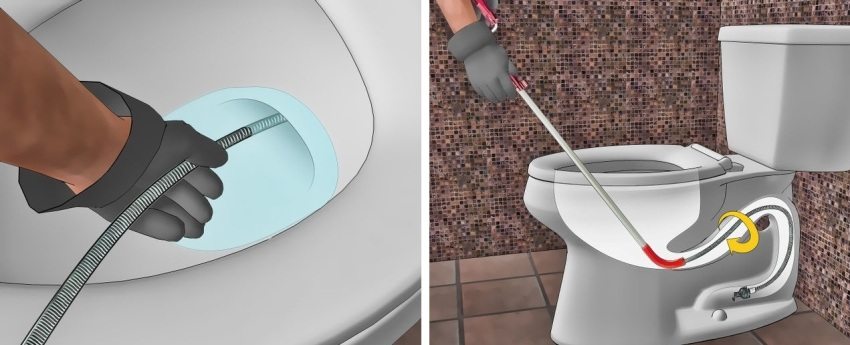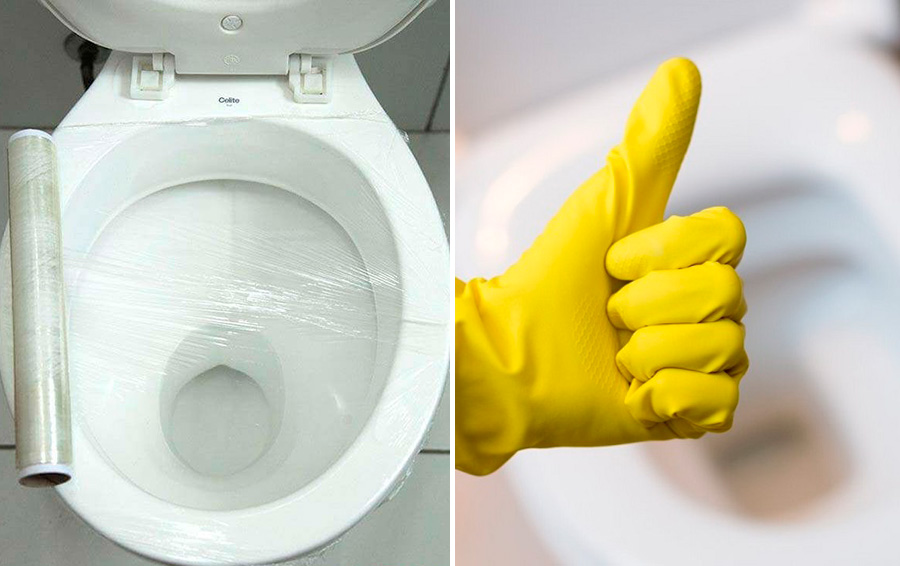How to clean the toilet at home
When the toilet bowl and the entire toilet room are kept in order, cleanliness and beauty, the whole house immediately becomes more comfortable. A white, perfect device without unnecessary stains and with a good quick drain completes the whole image of the apartment and the owners. And for the owners themselves, a device with a good drain makes life much easier. That is why it is important to know how to eliminate a blockage in the toilet on your own using folk remedies.

When a blockage appears in the toilet, it becomes a serious problem for the entire family. In addition, there is a danger of flooding the neighbors. Although it is believed that fixing such problems is a plumber's business, most people prefer to deal with this issue on their own. And the reason here is not only the saving of money for the service.

The main reasons are different. First, the solution to this issue is urgent, and it is not always convenient to wait for a plumber. For obvious reasons, you have to fix this problem quickly. Secondly, third-party craftsmen do not care about accuracy, they first of all do their job to remove the blockage. Therefore, after them you have to clean the entire bathroom. Because of this, most people prefer to deal with this problem on their own. So the question of how to clean the toilet using folk methods remains quite relevant.

Causes of clogging in the toilet
Before removing the blockage in the toilet, you need to determine its cause and location.

There may be several reasons for the appearance of such a problem:
- A large object falling into the drain: rags or sponges that accidentally and imperceptibly flowed out of a bucket of water.
- Food debris that can form large deposits. This can be a large leaf tea infusion or tea bags.
- Residues of mortars. It can be plaster, putty and other substances. They settle on the days of the pipe, where they form an initial tubercle, on which the same food debris and other debris then settle.
- Toilet paper and napkins. Typically, paper dissolves in water and leaks with it. But with old pipes, deposits on them from food debris and other obstacles, the paper is not eliminated into the sewer, but remains in the pipe. A large amount of it accumulates, which creates a blockage.
- Feminine hygiene products. They practically do not dissolve and very easily clog the drain.
- Filler for cat litter. In general, it is not recommended to throw it into the sewer, as it clogs it, but many are trying to simplify their life, as a result, they only get the opposite effect.
- Lime deposits from hard water. These deposits form gradually and provide excellent conditions for other large deposits to settle.

Blockages with such causes can be easily removed with conventional home remedies. In private homes, it can also be caused by improper installation or pipe laying. This can be a smaller pipe or an incorrect slope, lack of air access or freezing of the pipe. These are already more serious problems, which can be completely eliminated only with the help of a major overhaul of the sewage system. Simple folk tricks here will only have a temporary effect.

Determining the location of the blockage
After the cause of the blockage has been clarified, it is necessary to determine its place, and then decide on the method of elimination. The easiest way to get rid of the blockage located next to the toilet bowl is to get rid of it. And deposits that are located along the entire pipe are much more difficult to remove.

To do this, you need to watch how water leaves the sinks, bathtubs and toilet bowls. If the water slowly leaves only from the toilet, it means that there is a blockage near the bowl. This can be a siphon, collar or outlet pipe.
If the water is slowly drained from other places, then there is a blockage somewhere in the common place of the sewage system of an apartment or house.

And if a fountain comes out of the toilet, then the blockage is already in the riser. It will be difficult to remove such a problem on your own with simple means. This is where the urgent intervention of a plumber is needed.
Small blockages in pipes can be easily dealt with with improvised means. There are both special chemicals for cleaning pipes, and simple traditional methods that have been tested by time.

Chemical methods of pipe cleaning
When thinking about how to clean the toilet from a blockage, the first thing that comes to mind is the idea of using special solutions. The use of chemical reagents makes pipe cleaning convenient and quick. They are able to remove blockages in just a few minutes. The action of such funds as "Mole", "Domestos", "Mister Muscle" and others is based on a high concentration of acids or alkalis. That is, chemical reagents simply corrode the deposits in the pipe.

However, they also damage pipes. Due to the frequent use of such agents, microcracks appear in the pipes, due to which blockages will form more over time. Also, when using these funds, it is necessary to strictly follow the safety precautions and instructions for use. In particular, use gloves and, if possible, safety goggles. Otherwise, you can get chemical burns.

These agents help to clean pipes from blockages with deposits. They will not be able to remove a large object from the sewer, for example, a rag.
Hot water with soda
A simple and healthy alternative to chemicals is regular hot water with soda. The calculation of the composition is as follows: 500 grams of soda per 1 liter of boiling water. Soda is poured into a bucket of boiling water and immediately thrown into the drain hole. The solution should work within 10-15 minutes.

To enhance the effect, you can use baking soda and vinegar. In this case, soda is poured directly into the drain hole. Then vinegar is poured into it and boiling water is added sharply. The reaction between the baking soda and vinegar will produce carbon dioxide, which will eat away at the deposits in the pipe.

In addition to this method, there are many more folk remedies for cleaning pipes.
Effective cleaning products
The principle of all folk remedies for cleaning pipes is based on chemical reactions. Its purpose is to eat away rough and coarse deposits, after which they can be washed off. For this can be used:
- Oxalic acid is sold specifically for pipe cleaning. As a rule, one pack is enough. It is poured directly into the opening of the device and waited for a couple of hours. Then the water can be washed off, the remaining dirt in the pipe can be removed with a brush.
- Citric acid is used in powder form. Lemon juice will not be able to deal with dirt in such a device. 300-400 grams are dissolved in a liter of water and poured into the pipe. The substance should work within a few hours. After that, it is necessary to process the pipe with a brush, removing the remaining dirt.
- Chlorine. It is poured directly into the drain and left for several hours. Then the pipe is scraped off with a brush. When using this substance, it is necessary to observe safety measures - do not inhale, use gloves and goggles.
- Mustard powder. Pour into boiling water at the rate of 1 tablespoon per 2 liters of water. The solution is poured into the drain and wait 15-20 minutes. Repeat the procedure if necessary.
- Carbonated drinks "Coca-Cola", "Sprite" and others perfectly dissolve mineral deposits due to carbon dioxide and acid in their composition. After such use of drinks, the question arises about their benefits for the stomach and intestines. 1.5 liters of the drink is poured into the tube and left for 2 hours. The drink should not be dissolved with water. After that, the blockage is simply washed off.
Mechanical cleaning
Mechanical pipe cleaning is required to remove large objects that are difficult to dissolve. These can be rags, paper, toilet filler leftovers, napkins, and foreign objects that have accidentally fallen into the drain. The classic way to troubleshoot such problems is to use a plunger.

It is effective when the blockage has formed somewhere far away in the pipes. It is more convenient to use on flat surfaces, a bathtub is best for this. In this case, the other drain holes are covered with rags. The plunger is pressed tightly against the hole and the bath is filled with water. Then they abruptly tear it off the surface. In this case, a vacuum and negative pressure are formed in the pipe, which pulls out foreign objects and breaks through the plug.

However, using a plunger is not always effective, and it may not always be at hand. For this, there are alternative mechanical ways to clean the toilet at home.
Plastic bottle
Its principle of operation is similar to the plunger, but it will be more effective in the toilet. Since the plunger cannot be installed in this device. The width of a 1.5 liter bottle is fine for installation in a toilet bowl drain. To do this, the bottom is cut off, and the lid is tightly twisted. They are inserted into the hole of the plumbing and moved back and forth. The air in the bottle begins to press on the water and a water hammer is obtained, which breaks through the plug from the pollution. It is necessary to repeat the procedure several times, and then wash off the remnants of objects.

Film plunger
The action of this item is also based on the differential pressure. The advantage of the device is the absence of splashes and dirt in the bathroom. The device is filled with water and sealed with a plunger film. After that, pressure is applied to the film, due to which a water hammer is formed, and the plug in the pipe breaks through.

For the film, you can use commercial devices or regular wide tape. The latter is glued to the seat in several layers and fixed tightly.
Rope and "doll"
Any cable or rigid wire can be used for the wire rope. The end is usually twisted in a spring, leaving a sharp tip. The cable is pushed into the pipe, rotating as it goes through bends and turns. It is more convenient for two people to work at once - one pushes the cable, and the other turns it. With a certain skill, one person can cope. After using the tip it was possible to find a foreign object, the cable begins to move back and forth, stirring the cork. In this way, it is given either to pierce it, or by catching a foreign object to pull it back.

This method allows you to eliminate the traffic jam from large objects in remote and difficult hard-to-reach places.
Instead of a spring, you can use a solid object - "doll". The doll is usually pushed separately into the pipe, after having disconnected the plumbing. She pushes the plug in the direction of the riser.
What not to do
When a blockage appears, in no case should it be left to disappear on its own accord according to the principle "it will dissolve by itself." Unfortunately, this will not happen, and the plug can also clog the riser. Any blockage can damage the pipe and flood neighbors, which will entail large expenses for repairs.

When using chemicals, it is important to strictly follow the instructions and the concentration of the substance. It is also necessary to use gloves, goggles. In no case should you take deep breaths next to chemicals - this can lead to burns of the respiratory tract.

When using mechanical means, you should act carefully, without sudden movements. Otherwise, the siphon or corrugation may be damaged.
Preventive measures
Correct and timely care of plumbing fixtures will avoid blockages, traffic jams and other troubles. It should be remembered that large objects, including food debris, feminine hygiene products, cat litter, fat from pans, should not be flushed into the toilet. In addition, it is important to regularly carry out the following actions:
- Flush the drain daily with hot water or detergent. It takes 1-2 minutes, but saves several hours in the future.
- Clean the plumbing once a month with detergents or household products.
- Do not put paper and napkins into the bowl, but use a basket for this.

Simple preventive measures will help to avoid blockages and waste time and nerves on their elimination.
VIDEO: How to unclog a clogged toilet.










Discussions
Good article. Share where to order a sewer service?